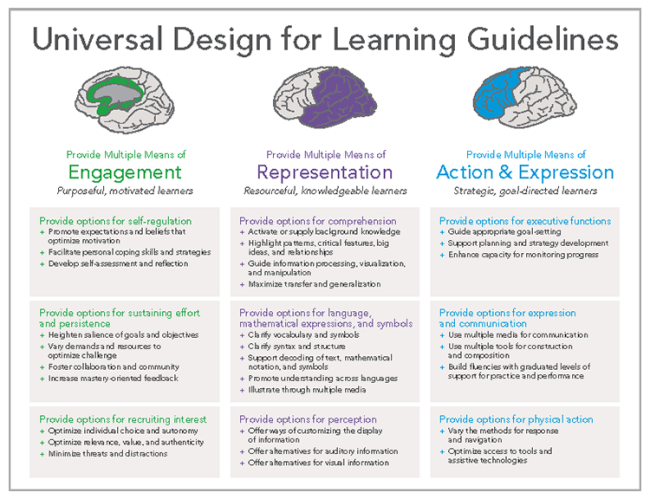You have /5 articles left.
Sign up for a free account or log in.

National Center for University Design for Learning
NEW ORLEANS -- Eric Moore, a universal design for learning and accessibility specialist for the University of Tennessee's office of information technology, instructed attendees at a panel last month at the Educause Learning Initiative (ELI) annual meeting to do something uncomfortable: describe their definition of diversity out loud in a 90-second video.
Audience members grimaced and grumbled but dutifully pulled out their smartphones. Some opted to type silently, while a few brave souls pressed “record” and murmured a response. Moore committed to his bit for the full 90-second assignment.
It was clear from the outset that Moore offered the exercise to illustrate a point: assessment must accurately reflect knowledge. Everyone in the audience assured Moore with raised hands that they could offer a reasonably coherent explanation of diversity -- but only in a more amenable format, like a face-to-face conversation or a written paragraph. Talking to one’s smartphone in a crowded room of peers and strangers, Moore admitted, “is really awkward.”
The exercise highlighted one of the major principles of universal design for learning, or UDL, a concept that emphasizes tech-driven, multifaceted approaches to improving students’ access to learning. The term is often mentioned in conjunction with accessibility initiatives for students with disabilities, but proponents say its effects ideally reach students of all backgrounds. Advocates hope educators increasingly see UDL as an attainable standard for course design -- one that penetrates curriculum and student-teacher interaction both in person and online.
The guiding principles of UDL encourage providing multiple means of representation (how learning materials are conveyed), action and expression (how students demonstrate comprehension of learning materials) and engagement (how students work with instructors and one another to deepen the learning experience). Implementations of the concept include offering information through both visual and auditory forms, optimizing access to tools and assistive technologies, and illustrating examples through multiple media.
Moore’s ELI session focused on practical techniques for introducing UDL to a campus seeking to engage students of diverse backgrounds. Here’s the process he and his colleagues have used to get the ball rolling.
1. Identify the UDL expert on campus
At the University of Tennessee, the UDL push began with Jean Derco, executive director of the institution’s office of information technology. She was already participating on an accessibility implementation team established in March 2015 when she stumbled upon Moore, then a graduate student and recently an intern at the Universal Design for Learning Implementation and Research Network (UDL-IRN). Moore’s idealism and organic interest in the ins and outs of UDL made him a natural fit to encourage and energize campuswide conversations around UDL, Derco said during the panel.
2. Amplify the UDL expert’s message
Derco and Moore quickly identified the institution’s office of information technology -- which encompasses multimedia specialists, instructional designers and instructional design support staff -- as the place to plant seeds for a campuswide UDL movement.
Informing employees in that division about UDL started simply, with a bulletin board outside their office and visits to professional development training sessions, during which Moore set aside 10 minutes to discuss one aspect of UDL. Eventually, the training grew more practical, as Moore would help instructional designers think with a UDL focus about requests from professors to evolve their courses.
3. Launch a campaign
Several instructors at the university have begun incorporating universal design for learning into their courses -- and attempting to convey its importance to the next generation of educators. Miriam Larson, an instructional designer and adjunct professor of instructional design, was one of the early guinea pigs for UDL. She wanted her students -- aspiring educators -- to understand the significance of UDL and accessibility issues, so she asked Moore to offer a brief introductory lecture and then required students to take Moore’s UDL on Canvas online course.
By the end of the semester, 80 percent of students reported positive feelings about that aspect of the course, and 30 percent identified UDL and accessibility among their top five takeaways from the course. On the other hand, some students said the hefty UDL concept came too soon in the course after their introduction to the broader concept of instructional design; Larson plans to put UDL later in the semester next time.
4. Foster systemic cultural change
Derco said Moore has been instrumental in starting a conversation on campus about UDL.
Each week he sends five letters to departments inviting them to chat about his team’s progress. Those dispatches have to be short, though. “I find if I do a whole page-long email, it’s over,” he said.
Still, the upper reaches of the institutional hierarchy, including the chancellor and some deans, remain to be reached. Derco said Moore has been a strong idealistic voice but sometimes needs to be reminded that the pace of change can be grueling.
“Culture change takes time,” Moore admitted during the panel. “Our goal is to change the campus culture at UT to be a place that’s known [as a] place of inclusion and diversity.”








